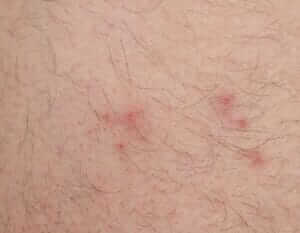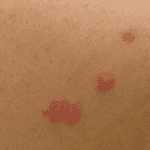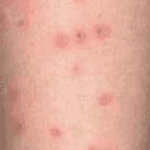Bug bites can cause a variety of reactions, from mild discomfort to more serious health concerns. Identifying the type of bite ensures effective treatment and reduces the risk of complications. This guide provides a detailed look at various bug bites, including their appearance, symptoms, and treatment.
Appearance & Symptoms: Mosquito bites are small, round, raised bumps that become red and inflamed. The bite site may be slightly swollen, with a visible puncture mark. Symptoms include itching, mild swelling, and in some cases, a rash, especially for individuals with sensitivity to mosquito saliva.

Treatment: Wash the bite with soap and water to reduce infection risk. Applying a cold compress can help minimize swelling and alleviate itching. Anti-itch creams or oral antihistamines are effective in managing symptoms. If fever, joint pain, or a rash develops, seek medical attention, as these could indicate a mosquito-borne illness such as West Nile virus or dengue.
Appearance & Symptoms: Tick bites appear as small, red bumps and may not cause immediate pain. If the tick is still attached, it can look like a tiny dark speck embedded in the skin. Symptoms can include a circular "bull's-eye" rash, body aches, or muscle pain, often developing a few hours to days after the bite if the tick carries a disease.
Treatment: Use fine-tipped tweezers to carefully remove the tick, ensuring the entire tick is extracted. Clean the area with antiseptic and monitor for symptoms such as fever, fatigue, or expanding redness. Consult a healthcare provider if symptoms develop, as tick bites can transmit diseases like Lyme disease and Rocky Mountain spotted fever.

Appearance & Symptoms: Flea bites often appear as small, red, itchy spots with a central puncture mark, typically found in clusters on the legs, feet, or ankles. These bites can cause significant itching, redness, and swelling. Excessive scratching may lead to skin infections.

Treatment: Wash the affected area with soap and water. Apply anti-itch creams or take oral antihistamines to alleviate itching. Avoid scratching to prevent skin infections. If fleas are present in your environment, consider professional pest control to address the infestation.
Appearance & Symptoms: Spider bites vary from small red marks to significant swelling or lesions. Brown recluse spider bites may show two puncture marks and develop into a blister or ulcer. Symptoms can include redness, itching, intense pain, and in severe cases, muscle cramps or flu-like symptoms.
Treatment: Clean the bite area with soap and water, then apply a cold compress to reduce swelling. Over-the-counter pain relief and anti-itch medications can help manage symptoms. If you suspect a venomous spider bite, such as from a brown recluse or black widow, seek medical attention immediately, as these bites can cause tissue damage or systemic reactions.

Appearance & Symptoms:
Bed bug bites are red, itchy bumps that usually appear in lines or clusters. The bites can vary in size and may feature a small blister at the centre. Common symptoms include itching, redness, and swelling.

Treatment: Wash the affected area thoroughly with soap and water. Use anti-itch creams or take oral antihistamines to relieve itching. If secondary infections develop from scratching, seek medical treatment. For recurring bed bug bites, consult a pest control specialist, as infestations can be challenging to eliminate.
Appearance & Symptoms: Ant bites, particularly from fire ants, cause small, red bumps that can turn into blisters. The bites often appear in clusters, resulting in sharp stinging pain and sometimes a burning sensation.
Treatment: Clean the bite site with soap and water to avoid infection. Applying a cold compress can help reduce swelling and discomfort. Anti-itch treatments can relieve symptoms. In cases of severe allergic reactions, such as difficulty breathing or widespread swelling, seek emergency medical help immediately.

Appearance & Symptoms: Blister beetle bites may cause red, inflamed skin that can develop into a fluid-filled blister. The surrounding area may appear swollen and irritated.

Treatment: Gently wash the affected skin with soap and water, and avoid bursting the blisters. Cover the bite with a sterile bandage to protect against infection. If the reaction becomes more severe or spreads, consult a healthcare professional, as blister beetle toxins can cause significant skin irritation.
Appearance & Symptoms: Horsefly bites are painful, resulting in a raised, red bump that is often inflamed. The bite may cause a burning or itching sensation, accompanied by swelling around the area.
Treatment: Clean the bite area thoroughly with soap and water. Apply a cold compress to reduce swelling, and use anti-itch creams for relief. If signs of infection develop, such as increased redness, warmth, or pus, seek medical advice.

Appearance & Symptoms: Scabies mites cause small red bumps or blisters that often appear in lines or clusters along the skin where the mites have burrowed. Intense itching, particularly at night, is the primary symptom.

Treatment: Prescription medications are needed to eliminate the mites and relieve symptoms. Wash all clothing, bedding, and towels in hot water to prevent re-infestation. Avoid close physical contact with others until treatment is complete, as scabies is highly contagious.
Appearance & Symptoms: Lice bites appear as tiny red bumps on the scalp, neck, or other infested body areas. They cause persistent itching, often accompanied by visible nits (lice eggs) in the hair.
Treatment: Over-the-counter lice treatments containing permethrin or pyrethrin are effective for killing lice. Use a fine-toothed comb to remove dead lice and nits. If itching persists after treatment, consult a healthcare provider for prescription medication. Washing clothing and bedding in hot water can help prevent re-infestation.

Bug bites can sometimes resemble other skin conditions, such as eczema, psoriasis, or even skin cancer. For example, a brown recluse spider bite may appear similar to certain types of skin lesions. If a bite does not heal, worsens, or looks unusual, it's important to consult a healthcare professional for an accurate diagnosis and appropriate treatment. Understanding how to identify and treat different types of bug bites can help you manage symptoms effectively and reduce the risk of complications. For pest control services, contact GL Pest Control!



